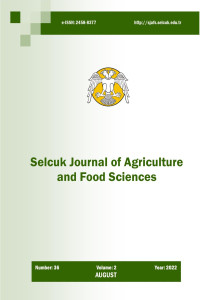Abstract
This study aimed to determine the potato breeding lines that show superior agricultural characteristics and can be variety candidates by selection. The experiment was arranged in a randomized complete blocks design in both years with four replications. In the study, 20 potato breeding lines developed by Selcuk University, Faculty of Agriculture, Department of Field Crops and 18 registered
varieties as plant material were used in the first year. In the second year, the study continued with 7 breeding lines and 8 registered varieties that were at the end of the first year. In the study; emergence period (days), maturation time (1-9 scale), plant growth type (3-7 scale), plant height (cm), number of main stems per plant (pieces), number of tubers per hill (pieces), average tuber weight (g), tuber yield per hill (g), total, large, medium small, discarded tuber yields (kg da-1), number of eyes per tuber (piece), tuber shape (1-9 scale) were examined. In all field parameters, the differences between genotype in 2019 and between location, genotype and location x genotype interactions in 2020 were statistically significant. The total tuber yield varied between 2001.2 kg da-1
and 6029.8 kg da-1 in 2019. For the year 2020; It was determined between 2766.4 kg da-1 and 5598.2 kg da-1. Among the potato breeding lines in both years, ELAF11 (6029.8 kg da-1 in 2019; 4939.9 kg da-1
as genotype average in 2020) was the leading line in terms of total tuber yield per decare. Overall, the potato breeding lines that gave the best results differed. ELAF11 and ELAF10 lines were determined
as potato breeding lines with high tuber yield.
Details
| Primary Language | English |
|---|---|
| Subjects | Agronomy |
| Journal Section | Research Article |
| Authors | |
| Publication Date | August 25, 2022 |
| Submission Date | May 24, 2022 |
| Published in Issue | Year 2022 Volume: 36 Issue: 2 |
Cite
Selcuk Agricultural and Food Sciences is licensed under a Creative Commons Attribution-NonCommercial 4.0 International License (CC BY NC).


